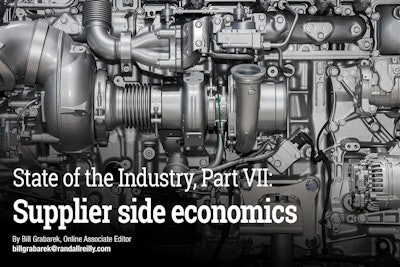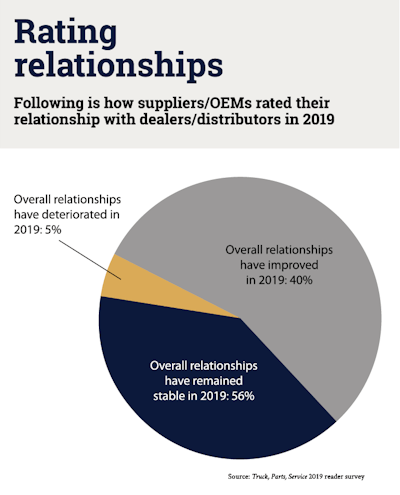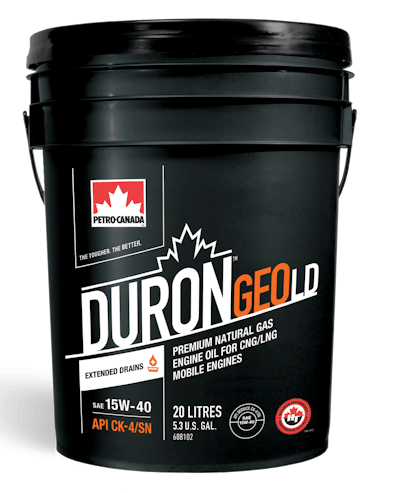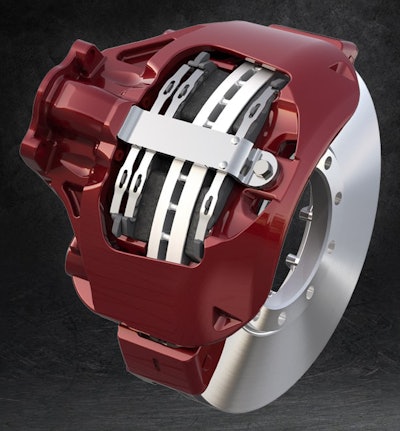
In addition to recapping factors affecting their business, popular sellers and new products in 2018 and 2019, suppliers turn their attention to 2020.
A look back
 Click to enlarge.
Click to enlarge.The last couple of years have been strong for Paccar Parts Fleet Services with regard to national account business, says Mark Santschi, director of fleet services, Paccar Parts.
“We cater to national and regional fleet operators who are looking to increase ease of doing business and reduce total cost of ownership and, in 2019, we have been more reliant on data analytics to pinpoint opportunities for us and for our customers,” Santschi says.
For 2018 there was an expectation that the heavy-duty market in the U.S. would rebound coming off a 255,000-build in 2017, says Paul Paré, senior director, marketing and business development, Jacobs Vehicle Systems.
“The real question that we struggled with was, would it be sustainable throughout the year and, if so, how long and could it also continue into 2019? The challenge of that question was whether we should invest in capital with the uncertainty or try to manage the business with our current capacity,” Paré says. “The short answer is that we did invest in capital both from a labor and machine perspective.”
Regarding the latter, recruiting the necessary hourly and salaried associates to support the growing business was one of the company’s biggest challenges in 2018 and 2019, Paré says.
Over the last couple of years, significant progress has been made in the industry’s transition to API CK-4 and FA-4 heavy-duty diesel engine oils. It has been a gradual process across the heavy-duty industry to transition fleets and equipment to more efficient and protective lubricants, according to Ron LeBlanc Sr., senior technical services advisor, Petro-Canada Lubricants.
“In the past two years, Petro-Canada Lubricants has launched extended product ranges and introduced new product lines to meet the evolving needs of heavy-duty fleet and equipment operators,” LeBlanc says.
In 2018 Petro-Canada Lubricants launched Traxon Synthetic MTF 75W-80, while more recently in 2019 the company launched Duron GEO LD 15W-40 and 10W-30, along with Duron Advanced 5W-30, DuraDrive Heavy Duty Long Drain Automatic Transmission Fluid and Traxon Synthetic 75W-85.
Carl Mesker, vice president sales, Americas, SAF-Holland, says sales the last two years were “extraordinarily good” but 2019 did not have the “unbridled growth” the company saw in 2018.
Electrification is becoming an increasingly significant trend for Dana Incorporated’s business, says Dan Griffin, Dana senior director of strategy, product planning and program management, commercial vehicle and aftermarket.
Griffin says Dana has made several acquisitions over the last two years that have given the company the ability to provide complete e-powertrains for its customers.
“We recently announced a significant new electrified program with a major customer on a medium-duty truck program representing $200 million in incremental sales,” Griffin says. “Securing this type of leadership role in electrification for the original equipment side of the business also means looking at how we prepare to support these vehicles in the aftermarket.”
 Carrier Transicold is seeing greater interest in alternative power sources, such as solar panels.
Carrier Transicold is seeing greater interest in alternative power sources, such as solar panels.Carrier Transicold’s Patrick McDonald, product manager – trailer products, says the company is seeing continued adoption of all-electric transport refrigeration systems and greater interest in alternative power sources and electronic functionality, such as solar panels and telematics.
“Improvements in batteries and solar power systems may not be advanced enough yet to remove the engine from the trailer refrigeration equation, but a greater number of food distribution operations are finding that trailer-mounted solar panels can be helpful in maintaining the charge of refrigeration unit batteries,” McDonald says. “These batteries are increasingly being used to power additional electronics such as telematics devices, fuel-level sensors, interior trailer lighting and other accessories.”
Ray Newman, program manager – telematics, Carrier Transicold, says, “the use of telematics for asset location and logistics management has been in our industry segment for some time, but its application for refrigerated loads transported over the highways has grown tremendously over the past few years.”
The prior two years also have been progressively stronger years industry-wide for commercial vehicles and truck components, Meritor says. “Although Meritor has enjoyed success, Meritor continues to look forward to providing new solutions and advanced products,” the company adds.
Factors affecting business
Just as Paccar Parts is exploring more efficient and creative ways to organize and consume data, so too are its customers, Santschi says.
“We have seen an increase in requests for data that can help fleets better manage their business. We have also noticed more fleets digging into their purchase histories and inventory management practices in order to consolidate spending and improve stocking strategies internally with facing dealerships or at supporting Paccar Parts distribution centers,” he says.
The major factor currently affecting Jacobs’ business is the downturn that is occurring now, Paré says.
“The market has been showing signs of slowing for the past four to five months, but the change in demand has taken much longer to materialize as the OEMs have been very slow to ramp down build schedules,” Paré says in a mid-October interview. “Some of the indicators could be seen in the historically high backlogs that existed due to the abnormally high order rates that occurred in late 2018. For the past seven to eight months, we have seen orders, even from a seasonal perspective, at very low levels, yet the OEMs are just now adjusting their build rates.”
Mesker says tariffs are having an effect on SAF-Holland’s business, “but we have learned more about creative sourcing than I thought we could ever know.”
He adds the trend of fleets moving back to mechanical suspensions also has impacted the company. “Air ride suspensions are about half the OEM’s on-highway trailer build now and we expect it to stay there,” Mesker says.
Focusing on the brake side of Meritor’s business, Justin McCoy, senior product manager for air disc brake (ADB), says a growing number of fleets are adopting ADB versus traditional drum brakes.
“The adoption of technologies like collision avoidance systems and traction control relies on the capabilities of the braking system making use of the stopping distance advantage of ADB,” McCoy says. “ADB have also provided substantial labor time savings to fleets for maintenance and repair.”
What’s popular
Paccar Parts says its line of TRP-branded all-makes parts has outpaced its overall growth with national accounts — considerably more so in 2019 than in previous years.
“TRP is still a relatively small portion of our total sales to large fleet customers, but the brand has clearly made an impact with certain customers. Fleets with longer trade cycles and an affinity for quality aftermarket alternatives have seen the benefits of TRP and the cost savings it can provide,” Santschi says.
“We tend to be strategic about how we present TRP options to fleets, and we have seen that those who do sample the brand often request additional options,” he adds.
 To meet the needs of mixed fleets, Petro-Canada Lubricants reformulated and relaunched Duron GEO LD, a heavy-duty engine oil offering protection for compressed natural gas, liquified natural gas and diesel and gasoline powered engines.
To meet the needs of mixed fleets, Petro-Canada Lubricants reformulated and relaunched Duron GEO LD, a heavy-duty engine oil offering protection for compressed natural gas, liquified natural gas and diesel and gasoline powered engines.Across the industry, there is a trend toward alternative fuels such as liquified natural gas, which has resulted in many of Petro-Canada Lubricants customers now operating mixed fuel fleets, LeBlanc says.
“To meet the diverse needs of mixed fleets, we reformulated and relaunched Duron GEO LD, a single heavy-duty engine oil that offers advanced protection for compressed natural gas, liquified natural gas and diesel and gasoline powered engines,” he says.
Mesker says the one product line selling better than any other product line is the SAF-Holland air disc brake product line.
“We are just getting started with that product line but it has proven to be a reliable and cost-effective system for the fleets, and now the aftermarket is beginning to grow because of our large first fit percentage over the past few years,” Mesker says. “We also now offer a full complement of air disc brake service parts for all makes with our Gold Line Quality Parts line.”
Fleets standardizing system components for maintenance efficiencies also are pushing air disc brake adoption, adds Meritor.
“Once a fleet invests in ADB technology, the deployment of ADB has often been rapid,” McCoy says. “With the adoption of ADB, we have witnessed the switch over often occurring for all axles on the truck, not just front axle.”
Griffin says Dana is seeing an increased interest in last-mile delivery, which is driving the need for new solutions for medium-duty truck platforms.
“For example, Dana recently launched a replacement genuine Spicer driveshaft for the Sprinter van that is pre-balanced and serviceable, making it easy for local installers to service quickly,” Griffin says. “We also launched Victor Reinz engine gasket sets for the Sprinter that will help to improve uptime for these vehicles, which are becoming strategically important for our customers.”
In addition to the traditional role of selling, installing and servicing transport refrigeration equipment, dealers today are increasingly engaged with their customers for the deployment of telematics solutions, Newman says.
“Dealers handle the setup and activation of the service before turning the equipment over to the fleet. With Carrier Transicold’s eSolutions system, dealers can view their customers’ fleets in operation across the country and expand their services to include ongoing equipment monitoring and troubleshooting for their customers,” he says.
A look at 2020 (and beyond)
Paccar Parts says the truck market in 2020 likely will shift to a more normalized demand compared with the past couple years.
From an aftermarket perspective, that is something we keep an eye on, especially as it relates to fleets’ appetite for replacement parts,” Santschi says. “Additionally, pressure on freight rates and the ever-present challenge of finding quality drivers keep us focused on supporting customers’ need to reduce their time in service bays so that they can keep operating and keep their drivers happy.”
Paré says the major unknown for 2020 is how steep will the cliff for new truck sales be in North America, coming off two very strong years in 2018 and 2019, which will impact how Jacobs staffs its business going into 2020.
“Currently the forecasts show a slightly lower-than-average year but, coming down from a very high-peak volume year, the percent decrease is what corporations are focused on,” he says.
LeBlanc says API CK-4 products have been more widely adopted than FA-4 engine oils because of their backward compatibility. However, as fleets move toward newer vehicles and engines, the sales and market share of FA-4 products will increase.
“We are also seeing a trend in fleets moving to lower viscosity engine oils within the API CK-4 line, such as SAE 10W-30 oils. Lower viscosity engine oils reduce viscous drag on moving parts, enabling the oil to flow more efficiently through the engine … and help to decrease the warmup time of engines,” LeBlanc says.
SAF-Holland’s 2020, as well as years to come, will focus on technology. For example, its revised POD Plus (parts on demand) online parts catalog, which will be intuitive and fast, is launching in early 2020, Mesker says.
 Meritor’s lightweight, single-piston EX+ LS air disc brake comes standard with MA9300 N-level proprietary friction.
Meritor’s lightweight, single-piston EX+ LS air disc brake comes standard with MA9300 N-level proprietary friction.Another example is the company’s Smart Steel intiative. “It is centered around our vision to add digital connection technology that brings to life our products with beneficial features with the fleet’s future vehicle telemetry needs in mind,” he says.
Digital platforms and e-commerce continue to be an important area of growth for Dana so it can provide customers with access to products quickly, Griffin says. “We have been adding dedicated customer resources and support to ensure responsiveness and fast delivery times,” he adds.
Meritor says some forecasts show 30 percent of the North American market will be specifying ADB by 2020, compared with 10 percent in 2010.
“With a comprehensive portfolio of air disc brake products, Meritor continues to position itself for success in 2020 and 2021,” McCoy says.
(Editor’s note: Part VIII of the TPS State of the Industry report takes a look at OEMs and the return to normalcy.)
State of the Industry, Part V: Dealerships address company plans and trends for 2020











